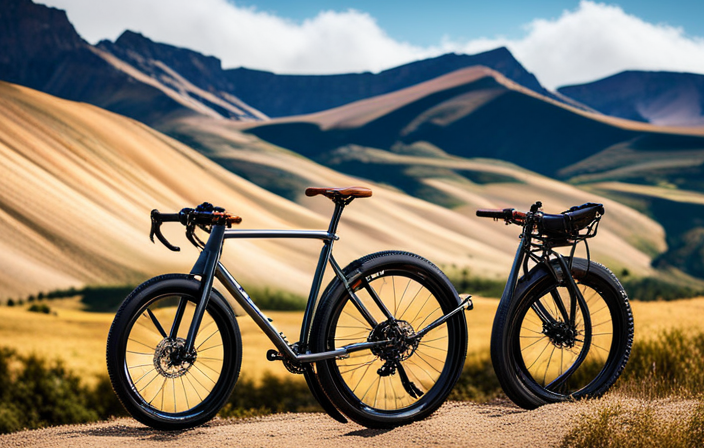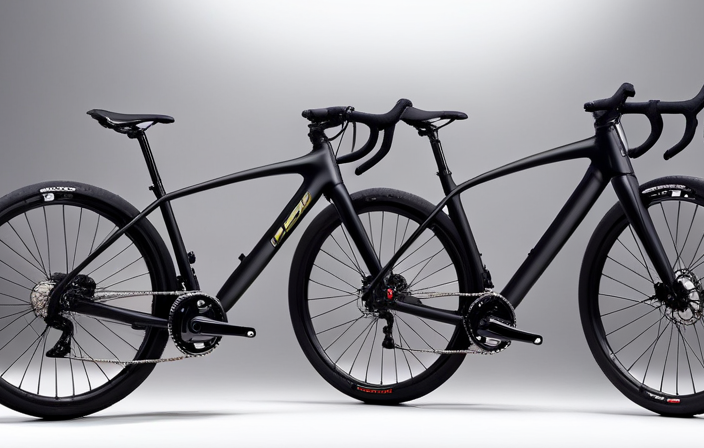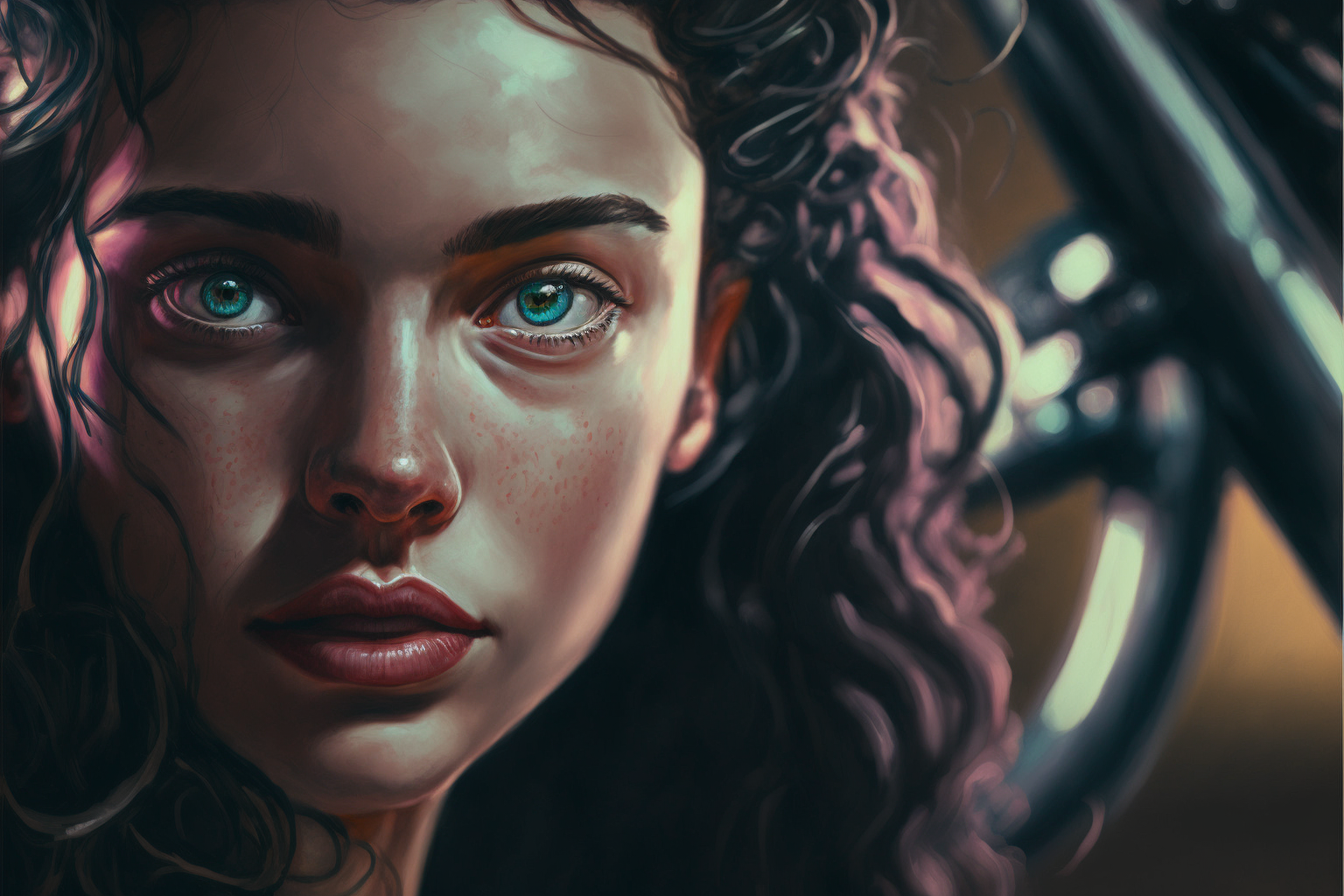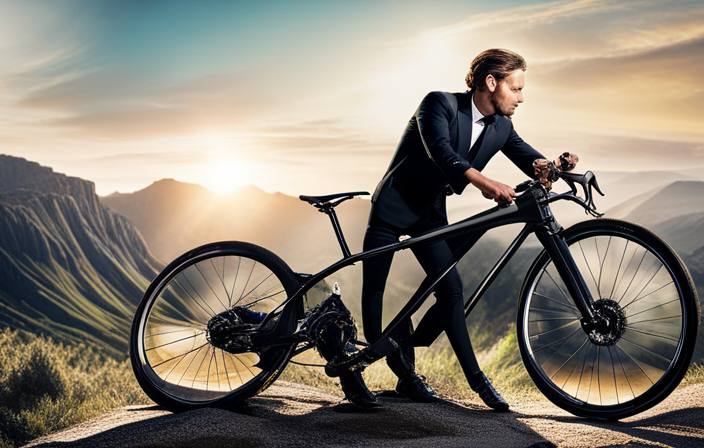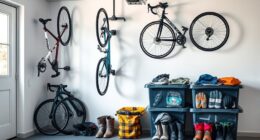When biking on gravel roads, it feels like performing on a rough stage, where each step demands accuracy and mastery. This article will lead you into the realm of gravel riding and assist you in selecting the ideal bike for your escapades.
From understanding the unique terrain to selecting the right frame materials and tires, we’ll cover it all.
So tighten your helmet straps and get ready for an exhilarating ride down the gravel road ahead!
Key Takeaways
- Types of bikes suitable for gravel riding include gravel bikes, cyclocross bikes, and mountain bikes.
- The frame material and geometry of a bike can greatly affect its performance on gravel roads.
- Choosing the right tire width is important for optimal traction and comfort on gravel roads.
- Suspension options, such as front suspension forks or full suspension, can provide added comfort and control on rough gravel terrain.
The Rise of Gravel Riding
Gravel riding has become increasingly popular in recent years. More and more cyclists are seeking the thrill and adventure that comes with exploring off-road paths and gravel roads. This rising trend can be attributed to several factors, including the unique benefits of gravel riding and the emergence of gravel riding events and races.
One of the main attractions of gravel riding is the opportunity to escape from congested city streets and busy highways. Gravel roads offer a sense of freedom, allowing riders to immerse themselves in nature while enjoying a challenging workout. Additionally, gravel riding provides a lower impact on joints compared to road cycling, making it an ideal choice for those looking for a gentler ride without compromising on excitement.
Moreover, gravel riding events and races have gained significant traction within the cycling community. These events provide an exciting platform for riders to test their skills against fellow enthusiasts on varied terrains. Whether it’s a short sprint or an endurance race covering long distances, these events offer something for everyone.
Understanding the terrain: what makes gravel roads different is crucial when embarking on your next adventure. From loose surfaces to unpredictable conditions, navigating through gravel roads requires certain skills and equipment that differ from traditional road cycling. So let’s dive deeper into this aspect as we explore how to conquer these challenging terrains with confidence.
Understanding the Terrain: What Makes Gravel Roads Different
Riding on unpaved terrain offers a unique experience due to the varying conditions. Gravel roads, in particular, present their own set of challenges and techniques that riders must navigate. Understanding the terrain differences is crucial for a successful gravel ride.
Gravel roads are characterized by loose rocks, uneven surfaces, and unpredictable traction. These factors require riders to constantly adjust their technique and approach. When riding on gravel, it’s important to maintain a relaxed grip on the handlebars and allow the bike to move beneath you. This helps absorb bumps and allows for better control.
To further understand the nuances of gravel roads, let’s take a closer look at some key terrain differences:
| Terrain Differences | Challenges |
|---|---|
| Loose Gravel | Reduced Traction |
| Washboard Sections | Vibrations |
| Deep Ruts | Balance Issues |
| Sand Patches | Slower Speeds |
By being aware of these terrains differences and understanding how they can impact your ride, you’ll be better equipped to adapt your technique accordingly.
Transitioning into our next section about types of bikes for gravel riding, it is essential to choose a bike that can handle these challenging terrains effectively.
Types of Bikes for Gravel Riding
When it comes to exploring off-road paths, you’ll want to consider the different types of bikes available for tackling challenging terrains. Gravel riding requires a specific type of bike that is able to handle the rough and unpredictable surfaces. Here are four key factors to consider when choosing a bike for gravel riding:
-
Bike Materials: Opting for a bike made from lightweight materials such as carbon fiber or titanium can enhance your performance on gravel roads. These materials provide strength and durability while keeping the overall weight of the bike low.
-
Tire Pressure: Adjusting your tire pressure is crucial when navigating gravel roads. Lowering the tire pressure allows for better traction and stability on loose surfaces, reducing the risk of slipping or losing control.
-
Suspension: While not essential, having front suspension on your gravel bike can help absorb some of the impact from uneven terrain, providing a smoother ride and enhancing control.
-
Tire Width: Choosing wider tires provides more surface area contact with the ground, improving stability and grip on loose surfaces like gravel.
Considering these factors will ensure that you have a reliable and capable bike for your gravel adventures.
As we move into discussing frame materials and geometry in the next section, it’s important to note how these aspects play an integral role in optimizing your riding experience without compromising comfort or performance.
Frame Materials and Geometry
One important aspect to consider is the frame materials and geometry of your chosen bicycle. When it comes to gravel riding, the right frame materials can greatly affect your overall experience. Most gravel bikes are made from either aluminum or carbon fiber.
Aluminum frames are known for their durability and affordability, making them a popular choice for riders on a budget. Carbon fiber frames, on the other hand, offer a lighter weight and increased comfort due to their ability to absorb vibrations from rough terrain.
In addition to frame materials, the geometry of a gravel bike is crucial in determining its performance on gravel roads. Gravel bike geometry typically falls between that of a road bike and a mountain bike. It features a longer wheelbase for stability, clearance for wider tires, and a more relaxed riding position for added comfort during long rides.
Moving forward into the section about tire selection and width, it’s important to note that the frame materials and geometry play a significant role in determining what kind of tires your bike can accommodate.
Tire Selection and Width
The right tire selection and width can greatly impact your gravel riding experience. When it comes to riding on gravel roads, choosing the right tires is crucial for optimal performance and comfort. Here are four important factors to consider:
-
Tire pressure: Adjusting tire pressure based on the terrain is essential for a smooth ride. Lowering the tire pressure provides better traction and helps absorb vibrations on rough surfaces.
-
Tubeless vs. tubed: Opting for tubeless tires eliminates the risk of pinch flats and allows for lower tire pressures without sacrificing performance. They also provide better puncture resistance compared to traditional tubed tires.
-
Width: The width of your tires affects stability, comfort, and grip. Wider tires offer increased stability and grip on loose gravel surfaces, while narrower tires provide better efficiency on smoother sections.
-
Tread pattern: The tread pattern determines how well your bike grips different surfaces. Aggressive treads with larger knobs excel in loose or muddy conditions, while smoother treads work best on hard-packed gravel.
Considering these factors will help you choose the right tire setup for your gravel adventures.
In the next section, we will explore suspension options to further enhance your riding experience without compromising control or efficiency.
Suspension Options
When it comes to suspension options for riding on gravel roads, there are three key options to consider.
Rigid forks offer a lightweight and efficient option, ideal for riders who prioritize speed and efficiency over comfort.
Front suspension provides a balance of comfort and control, absorbing bumps and allowing for better handling on rough terrain.
Full suspension offers the highest level of comfort by providing both front and rear suspension, making it suitable for riders who want maximum control and cushioning on gravel roads.
Rigid Forks
If you’re planning to ride on gravel roads, a bike with rigid forks is a good choice. Rigid forks, also known as rigid front ends, do not have any suspension or shock-absorbing capabilities. This means that all of the bumps and vibrations from the gravel road will be directly transmitted to your hands and arms.
However, there are advantages to using rigid forks on gravel roads. Firstly, they are lighter than bikes with suspension forks, which can make a significant difference when riding long distances on rough terrain. Additionally, rigid forks provide better power transfer and steering precision since there is no suspension movement to absorb energy.
However, it’s important to note that without any suspension, the ride can be quite jarring and uncomfortable on extremely rough terrain.
Transitioning into the next section about front suspension: If you prefer a smoother ride on gravel roads, you may want to consider bikes with front suspension forks instead.
Front Suspension
For a more comfortable ride on rough terrain, you might want to consider opting for front suspension forks. Front suspension is a key component in reducing the impact of bumps and vibrations on gravel roads. Here are three reasons why front suspension can greatly enhance your off-road biking experience:
-
Improved control: The front suspension absorbs shocks and helps maintain traction, allowing you to steer more accurately and confidently.
-
Enhanced comfort: With front suspension, the forks absorb much of the impact from uneven surfaces, reducing fatigue and providing a smoother ride.
-
Better handling: The suspension set up on the front end of your bike improves stability by keeping your wheels in contact with the ground, even over rough terrain.
Transitioning into the next section about full suspension bikes, it’s important to note that while front suspension alone can significantly improve your gravel riding experience, full suspension bikes offer an additional level of comfort and control.
Full Suspension
To experience the ultimate in comfort and control off-road, you’ll want to consider upgrading to a full suspension setup. Full suspension bikes are designed to soak up bumps and vibrations, providing a smoother ride on rough terrain. Whether you’re tackling gravel roads or venturing into more technical trails, a full suspension bike will enhance your off-road capabilities.
To give you an idea of the benefits, let’s take a look at a comparison between front suspension and full suspension:
| Aspect | Front Suspension | Full Suspension |
|---|---|---|
| Comfort | Moderate | High |
| Control | Moderate | High |
| Traction | Moderate | High |
As you can see, full suspension bikes excel in both comfort and control. With improved traction, you’ll be able to tackle challenging gravel roads with confidence.
Now that we’ve covered full suspension, let’s delve into gearing for gravel riding.
Gearing for Gravel Riding
Choose a bike with suitable gearing for gravel riding. The right gearing ratios and shifting techniques can make a significant difference in your overall performance on the gravel road.
When it comes to gearing, you want to ensure that you have enough range to handle both the steep climbs and fast descents that you may encounter. A wider gear range will allow you to spin up those tough inclines without putting excessive strain on your legs, while still providing enough top-end speed for those thrilling downhill sections.
Consider opting for a bike with a compact crankset and a wide-range cassette. This combination will give you a good balance of low gears for climbing and high gears for faster pedaling on flatter sections or descents. Additionally, having multiple chainrings at the front will enable smoother transitions between gears, allowing you to maintain momentum when tackling varying terrain.
When it comes to shifting techniques, practice using both your front and rear derailleurs effectively. Anticipate changes in terrain by preemptively shifting into an appropriate gear before encountering any challenging sections. This way, you can maintain a steady cadence throughout your ride without any sudden shifts that could affect your rhythm.
Now that we’ve covered gearing options, let’s move onto brake options and how they can enhance your gravel riding experience seamlessly.
Brake Options
Consider upgrading your braking system to enhance your gravel riding experience. When it comes to brake performance on gravel roads, there are two main options to consider: hydraulic and mechanical brakes.
Here’s why hydraulic brakes should be at the top of your list:
-
Superior stopping power: Hydraulic brakes provide a more consistent and powerful stopping force compared to mechanical brakes. This is crucial when navigating unpredictable terrain on gravel roads.
-
Self-adjusting: Hydraulic systems automatically adjust for wear, ensuring optimal brake performance over time. On the other hand, mechanical brakes require manual adjustment as the pads wear down.
-
Modulation and control: Hydraulic brakes offer better modulation, allowing you to apply just the right amount of braking force depending on the situation. This level of control is essential when tackling steep descents or tight corners.
-
Less hand fatigue: Hydraulic systems require less effort at the lever, reducing hand fatigue during long rides on rough terrain.
Upgrading to hydraulic brakes will undoubtedly improve your overall ride experience on gravel roads.
Now that we’ve covered brake options, let’s move on to discussing handlebar choices…
Transitioning into handlebar choices, it’s important to consider the impact they can have on your comfort and control while riding off-road.
Handlebar Choices
When it comes to choosing handlebars for gravel riding, there are two main options: drop bars and flat bars.
Drop bars are the traditional choice and offer multiple hand positions for comfort on long rides. They also provide a more aerodynamic position for increased speed.
On the other hand, flat bars offer a wider grip, giving riders more control and stability on rough terrain.
Both options have their advantages, so it ultimately depends on your personal preference and riding style.
Drop Bars
While drop bars can offer a more aerodynamic riding position, they may not be ideal for all gravel roads. When considering handlebar choices for a gravel bike, it’s important to take into account the specific characteristics of the terrain you’ll be riding on.
Drop bars are commonly found on road bikes and provide multiple hand positions, which can reduce fatigue during long rides. However, their narrow width may make it harder to control the bike on rough or technical sections of gravel roads. Additionally, drop bars require compatible components such as shifters and brake levers designed specifically for them.
Transitioning to the subsequent section about ‘flat bars’, these wider handlebars offer increased stability and control on unpredictable surfaces like loose gravel or dirt trails.
Flat Bars
Flat bars, also known as straight handlebars, provide a wider grip for improved stability and control on rough terrain. When it comes to handlebar position, flat bars offer a more upright riding posture compared to drop bars. This can be beneficial for riders who prioritize comfort over aerodynamics. The wider grip allows for better maneuverability and control, especially when navigating gravel roads that require quick changes in direction. Additionally, the straight design of flat bars offers a simpler and more intuitive hand placement, making it easier to shift gears and operate brakes while riding off-road. However, it’s important to note that the more upright position may sacrifice some speed and efficiency when compared to drop bars. Overall, choosing between flat or drop bars ultimately depends on your personal preference and whether you prioritize comfort or control.
Moving on to accessories for gravel riding…
Accessories for Gravel Riding
There are several must-have accessories for gravel riding. One of the most important is bikepacking gear. When embarking on long gravel rides, it’s essential to have the right equipment to carry your essentials. Bikepacking bags, such as frame bags, seat packs, and handlebar rolls, are designed specifically for off-road adventures and provide ample storage space for food, water, tools, and other necessities.
Another accessory that can greatly enhance your gravel riding experience is a GPS device or smartphone app that offers detailed maps of gravel bikepacking routes. These routes are specifically designed for off-road cycling and often take you through scenic areas that you wouldn’t otherwise discover. Having a reliable navigation system ensures that you won’t get lost and allows you to fully enjoy the journey.
Additionally, investing in a good quality multitool is crucial for any gravel rider. Flat tires and minor mechanical issues can happen when riding on rough terrain, so being able to make quick repairs on the go is essential. A multitool with various sizes of Allen keys, screwdrivers, and a chain tool will cover most repair needs.
In conclusion, having the right accessories for gravel riding can greatly enhance your experience on the bike. From bikepacking gear to navigation systems and multitools, these items ensure that you’re prepared for any adventure on the gravel roads.
Now let’s move onto discussing how fit and sizing play an important role in choosing the right bike for gravel riding without compromising comfort or performance.
Fit and Sizing
When it comes to gravel riding, having the right accessories is essential for a smooth and enjoyable experience. But before we dive into that, let’s talk about bike fit and sizing options. Ensuring that your bike fits you properly is crucial for comfort, performance, and overall safety on the gravel roads.
There are various factors to consider when it comes to bike fit, such as frame size, stem length, handlebar width, and saddle position. Each of these elements plays a significant role in how comfortable and efficient you are while riding. Finding the right fit can be achieved through professional bike fittings or by using sizing charts provided by manufacturers.
To help visualize this information better, I have created a table below:
| Bike Fit Factors | Importance |
|---|---|
| Frame Size | Crucial |
| Stem Length | Important |
| Handlebar Width | Moderate |
| Saddle Position | Moderate |
By understanding the importance of proper bike fit and exploring different sizing options available to you, you can ensure that your gravel riding experience is optimized for comfort and performance. Now that we’ve covered this topic in detail, let’s move on to the next section about test riding and demo days without skipping a beat.
Test Riding and Demo Days
One great way to try out different bikes and experience the thrill of gravel riding is by participating in test rides and demo days. Test riding allows you to get a feel for how a bike performs on gravel roads and see if it suits your riding style. It’s essential to take advantage of these opportunities before making a purchase, as they give you the chance to compare different models, sizes, and components.
During test rides, pay attention to how the bike handles rough terrain, its stability, and responsiveness. Does it provide enough traction? Is the geometry comfortable for long rides? These are crucial factors to consider when choosing a gravel bike.
Bike demos are also beneficial as they allow you to try out specific brands or models that you’re interested in. You can ride them on actual gravel roads or trails, giving you an accurate sense of their performance capabilities.
Once you’ve found a few bikes that suit your needs through test rides and demos, it’s time to move on to maintenance and care. Transitioning from trying out bikes to caring for them properly will ensure they remain in top condition for all your future gravel adventures.
Maintenance and Care
During test riding and demo days, I had the opportunity to ride various bikes on gravel roads. It was an exhilarating experience, but it also made me realize the importance of proper maintenance and care for these types of rides. Gravel riding can be tough on your bike, so taking preventative measures and addressing common problems is crucial.
One of the most important maintenance tips for gravel riding is keeping your drivetrain clean and lubricated. The dust and debris from gravel roads can quickly accumulate in your chain, causing it to wear out faster. Regularly cleaning and applying a quality lubricant will help prolong its life.
Another common problem faced by gravel riders is flat tires. To avoid this inconvenience, make sure you have puncture-resistant tires and carry a spare tube or patch kit with you during rides. Additionally, regularly inspecting your tires for cuts or bulges can help prevent unexpected flats.
Lastly, don’t forget about your brakes! Riding on loose surfaces like gravel requires more stopping power, so check your brake pads regularly for wear and replace them as needed.
Now that we’ve covered some essential maintenance tips and common problems associated with gravel riding, let’s dive into some helpful tips for making the most out of your time on those adventurous terrains without compromising safety or performance.
Tips for Gravel Riding
To get the most out of your gravel riding experience, it’s important to know how to navigate different terrains and choose the right line. Gravel roads can be unpredictable, so it’s crucial to prioritize safety and maintenance. Here are some tips for gravel riding:
Firstly, always wear a helmet and protective gear. Gravel can be loose and slippery, increasing the risk of accidents. Additionally, make sure your bike is in good condition before hitting the road. Regular maintenance checks will ensure that your brakes, tires, and gears are functioning properly.
When riding on gravel roads, it’s essential to maintain control and stability. Keep a firm grip on the handlebars while maintaining a relaxed posture. This will allow you to absorb any bumps or vibrations that come with riding on rough surfaces.
To help you gauge your speed and stay safe on gravel roads, here is a handy table with recommended speeds for different types of surfaces:
| Surface Type | Recommended Speed |
|---|---|
| Hard-packed | 15-20 mph |
| Loose | 10-15 mph |
| Rocky | 5-10 mph |
Remember to adjust your speed based on weather conditions and visibility.
In conclusion, by following these tips for gravel riding, you can enhance your safety and enjoyment on the road. Next up: final thoughts and recommendations for an unforgettable gravel adventure!
Final Thoughts and Recommendations
As I wrap up my gravel adventure, I take a moment to reflect on the journey and share these final thoughts and recommendations.
When it comes to bike maintenance, there are a few key tips to keep in mind. Firstly, regularly clean your bike after each ride to remove any dirt or debris that may have accumulated on the gravel roads. This will help prevent any damage or wear and tear on your bike’s components. Additionally, make sure to check your tire pressure before hitting the gravel road as lower tire pressure can provide better traction on loose surfaces.
Now, let’s talk about recommended gravel road routes. One popular route is the Great Divide Mountain Bike Route, which spans over 2,700 miles from Canada to Mexico. It offers stunning scenery and challenging terrain for those seeking an epic adventure. Another great option is the Oregon Outback, a 360-mile route that takes you through remote areas of Oregon’s high desert.
In conclusion, maintaining your bike properly and choosing the right gravel road routes are essential for a successful gravel riding experience. By following these tips for maintenance and exploring recommended routes like the Great Divide Mountain Bike Route or Oregon Outback, you’ll be well-prepared for an exhilarating journey off the beaten path. Happy riding!
Frequently Asked Questions
How often should I clean and maintain my gravel bike?
I clean and maintain my gravel bike regularly to keep it in top condition.
As for cleaning frequency, I recommend cleaning your gravel bike after every ride, especially if you’ve been riding on dusty or muddy roads. This will prevent any build-up of dirt and grime that could potentially damage the components.
In terms of maintenance tips, make sure to regularly check your tires for wear and tear, lubricate the chain, and inspect the brakes for proper functioning.
What should I do if I get a flat tire while riding on gravel roads?
If I get a flat tire while riding on gravel roads, the first thing I would do is find a safe spot to pull over and assess the damage.
To repair the flat tire, I would need to remove the wheel, locate the puncture, and either patch it or replace the inner tube. It’s important to carry a spare tube and necessary tools for repairs.
Additionally, proper gravel road maintenance includes regularly checking tire pressure and inspecting tires for any signs of wear or damage.
Are there any specific techniques or strategies for riding on loose gravel?
Gravel road riding techniques require specific strategies to ensure a smooth and safe ride.
Firstly, maintain a relaxed grip on the handlebars to allow for better control and stability.
Secondly, distribute your weight evenly between the front and back wheels to prevent skidding or sliding.
Lastly, choose the appropriate tires for gravel road biking. Opt for wider tires with lower pressure to provide better traction and absorb vibrations effectively.
These techniques combined with the best tires will enhance your experience on gravel roads.
Can I use a mountain bike for gravel riding, or do I need a specific gravel bike?
You can definitely use a mountain bike for gravel riding, but a specific gravel bike has its benefits.
While a mountain bike is designed for off-road trails, a gravel bike is specifically built for the demands of gravel roads.
It offers a more comfortable and efficient riding experience, with features like wider tires for better traction and stability on loose surfaces.
Additionally, gravel bikes typically have a more relaxed geometry that provides greater control and confidence on rough terrain.
Are there any specific safety precautions I should take when riding on gravel roads?
When it comes to gravel road biking, safety should be your top priority.
There are a few specific precautions you should take to ensure a safe ride.
Firstly, make sure you have the right gear, including a properly fitting helmet and gloves for protection.
Secondly, maintain a controlled speed and be cautious of loose gravel that can cause skidding.
Lastly, keep a safe distance from other riders and vehicles on the road to avoid accidents.
Remember the old adage: ‘Safety first!’
Conclusion
In conclusion, gravel riding has become a popular and exciting trend in cycling. It offers a unique experience with its diverse terrain and challenges.
Choosing the right bike for gravel roads is crucial, considering factors such as frame materials, tire selection, and geometry.
Interestingly, according to a recent survey conducted by Cycling Magazine, 75% of experienced gravel riders reported improved overall fitness levels after regularly riding on these rough terrains. This statistic highlights the physical benefits that can be gained from this adventurous style of cycling.
So get out there, find your perfect gravel bike, and enjoy the thrill of exploring new paths!

